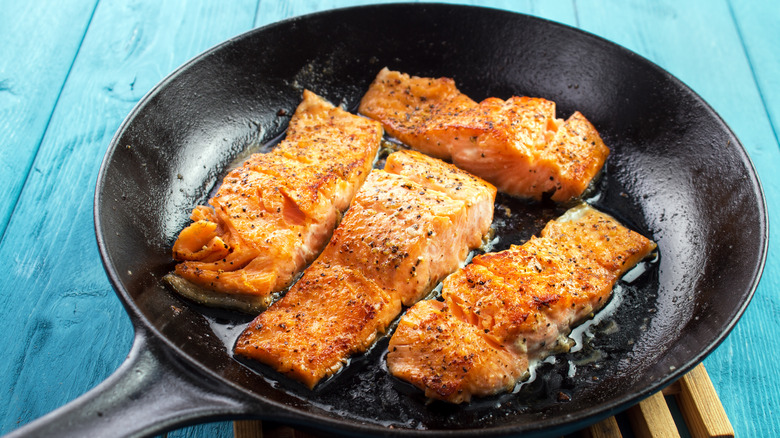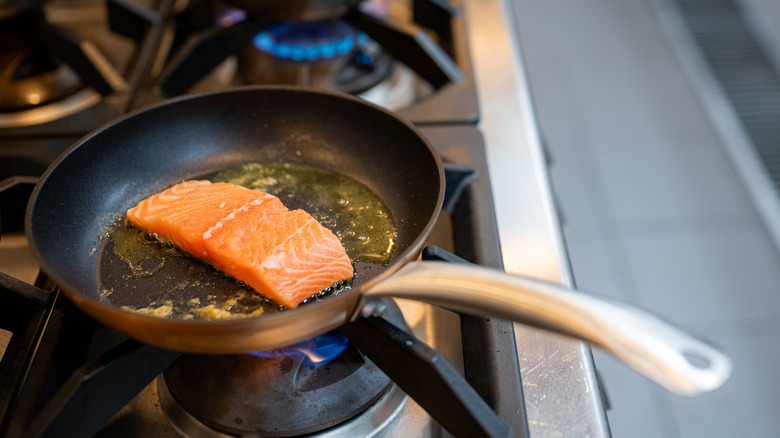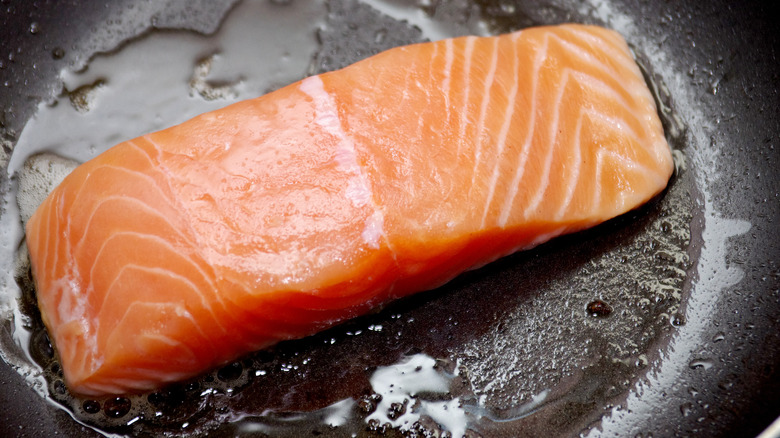Butter Vs Oil: Which Is Better For Salmon?
Cooking a salmon filet isn't a task to take lightly — literally. Besides the fact that it can be quite pricey to buy a high-quality salmon filet at the grocery store, you'll need to handle it with care during cooking because the meat is notoriously delicate. If you're not cautious with the heat, the salmon can easily become rubbery and tough from overcooking.
To pull it off, you'll need a good cooking medium that keeps the fish moist and flavorful and helps develop a nice crust, especially if you're going the pan-searing route. Butter and regular cooking oil are the most popular options, and although both can yield tasty results, each has its pros and cons.
Butter is a classic choice that imparts a rich flavor to the fish. Plus, it can also help somewhat with giving the fish a nice, golden-brown exterior. But neutral-flavored cooking oil is preferred by many, too, since it doesn't overwhelm the flavor of the fish like butter does, making it ideal for those who enjoy the natural flavor of salmon. Ultimately, you may wonder which is better for cooking salmon. The answer is a bit nuanced.
Butter's great if you like your salmon extra rich
If a steak can be cooked with butter, why not a salmon filet? Adding a knob of butter to a hot pan and letting it melt down serves as a great cooking medium for salmon. Similar to cooking a steak, the main advantage is the extra richness imparted by the butter. You can even enhance the flavor by adding garlic to create a fragrant garlic butter sauce to sear your fish in.
However, the biggest drawback of using butter is that, aside from masking the natural flavor of the salmon, it can burn quite easily. With a relatively low smoke point of 350 degrees Fahrenheit (the temperature at which it begins to smoke and burn), if you're not careful, you can easily "overcook" your butter. When this happens, the burnt butter will give the fish an acrid, bitter taste instead of the desired richness.
Cooking oil if you don't want to get too hands-on
Using cooking oil is perfect if you want to preserve the natural flavor of the salmon, and popular options like canola or vegetable oil offer a significant advantage: They're difficult to burn. For example, canola oil has a smoke point of 400 to 450 degrees Fahrenheit, while vegetable oil falls in a similar range (around 400 degrees Fahrenheit). Unless you crank the stove to the maximum and forget about it, your salmon should cook nicely in the pan without requiring constant attention.
The high smoke point of these oils also allows you to achieve a better crust on your salmon. Since you can heat the pan to a higher temperature than with butter, you can easily sear a flavorful crust onto the salmon without worrying about burning.
If you prefer a Mediterranean twist, you might opt for extra-virgin olive oil instead of canola oil. While it can have a lower smoke point and requires you to be a lot more careful while juggling the temperature knob to avoid burning, the delicate flavor it imparts to the salmon can be well worth the effort (especially once the salmon is paired with good wine!).


